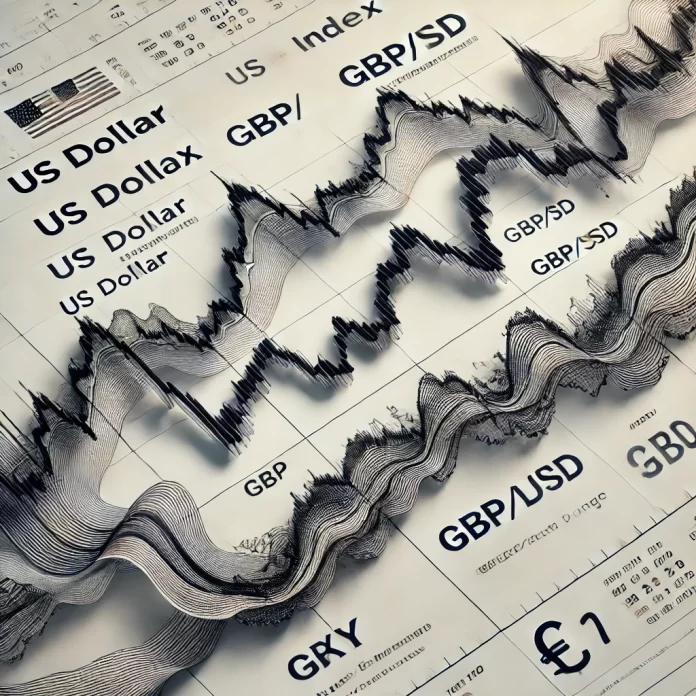Introduction
In a significant shift within the global currency markets, the US dollar has retreated, while the British pound (GBP) surged to its highest level in more than two years. This development reflects the ongoing complexities of the global economic landscape, characterized by fluctuating investor sentiment, varying economic policies, and geopolitical tensions. The contrasting trajectories of the US dollar and the sterling underscore the intricate dynamics at play in the forex markets, offering insights into the broader economic conditions influencing these movements.
The US Dollar’s Retreat
The US dollar, often seen as a safe-haven currency, experienced a notable retreat against a basket of major currencies, including the euro, yen, and sterling. This decline can be attributed to several factors, including shifting investor sentiment, changes in US economic data, and adjustments in Federal Reserve policy expectations.
One of the primary reasons for the dollar’s weakening is the mixed economic data emerging from the United States. Recent reports have indicated a slowdown in certain sectors, particularly in consumer spending and manufacturing. These developments have raised concerns about the resilience of the US economy, leading investors to reassess their expectations regarding future interest rate hikes by the Federal Reserve.
Moreover, the Federal Reserve’s cautious approach to monetary policy has also contributed to the dollar’s decline. While the central bank has signaled a willingness to maintain higher interest rates to combat inflation, it has also emphasized the need to avoid stifling economic growth. This balanced stance has led to uncertainty among investors, resulting in a reduced appetite for the dollar.
Sterling’s Surge To A Two-Year High
In contrast to the US dollar’s retreat, the British pound has experienced a remarkable resurgence, reaching its highest level in over two years. This surge has been fueled by a combination of favorable economic data from the United Kingdom and growing optimism about the country’s post-Brexit economic prospects.
The UK economy has shown signs of resilience, with key indicators such as GDP growth and employment figures surpassing expectations. The services sector, which plays a crucial role in the UK economy, has been particularly strong, contributing to the pound’s upward momentum. Additionally, the Bank of England’s hawkish stance on interest rates has bolstered investor confidence in the sterling.
The pound’s strength has also been supported by diminishing concerns over Brexit-related uncertainties. While challenges remain, the successful negotiation of trade deals and the implementation of new regulatory frameworks have provided a clearer path forward for the UK economy. As a result, investors have become more optimistic about the country’s long-term growth prospects, leading to increased demand for the sterling.
Market Reactions And Implications
The divergence in the trajectories of the US dollar and the British pound has sparked varied reactions in the forex markets. Traders and investors are closely monitoring these developments, adjusting their positions in response to changing economic conditions and policy signals.
For the US dollar, the retreat has raised questions about its status as the world’s primary reserve currency. While the dollar remains dominant, the recent decline has prompted discussions about potential shifts in global currency dynamics. Some analysts believe that the dollar’s weakening could signal a broader trend of diversification among global central banks and investors, with an increasing focus on alternative currencies such as the euro and the Chinese yuan.
On the other hand, the British pound’s resurgence has been welcomed by UK businesses and consumers, particularly those engaged in international trade. A stronger pound reduces the cost of imports, potentially leading to lower inflationary pressures. However, it also presents challenges for exporters, as their goods and services become more expensive for foreign buyers.
Geopolitical Factors And Future Outlook
Geopolitical factors have also played a significant role in the recent currency movements. The ongoing tensions between major global powers, including the United States, China, and Russia, have contributed to heightened volatility in the forex markets. These tensions, coupled with economic sanctions and trade disputes, have added to the uncertainty surrounding the US dollar.
Looking ahead, the future direction of the US dollar and the British pound will likely be influenced by several key factors. In the United States, the Federal Reserve’s monetary policy decisions, particularly regarding interest rates, will continue to be a critical driver of the dollar’s performance. Additionally, upcoming economic data, such as inflation and employment reports, will provide further insights into the strength of the US economy.
For the British pound, the focus will be on the UK’s economic recovery and the government’s ability to navigate the post-Brexit landscape effectively. Any signs of economic weakness or political instability could weigh on the pound, while positive developments could further boost its value.
Conclusion
The recent retreat of the US dollar and the surge of the British pound highlight the complex and interconnected nature of the global forex markets. These movements reflect not only economic fundamentals but also investor sentiment, geopolitical tensions, and central bank policies. As the global economy continues to navigate through uncertainty, the performance of these currencies will remain a key indicator of broader economic trends. Traders, investors, and policymakers alike will need to stay vigilant, adapting to the evolving landscape to navigate the challenges and opportunities that lie ahead.
